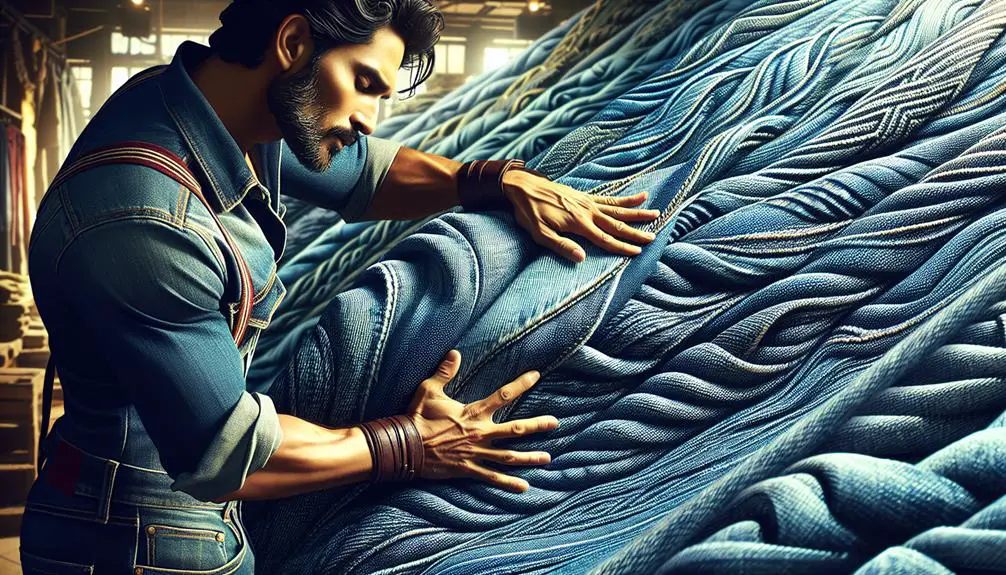Absolutely, I think rayon is great in jeans! It makes them softer and more comfortable, adding a nice stretch that really lets you move freely. Plus, it's breathable which is perfect for warmer days. And don't forget, rayon adds a beautiful drape to denim, making your jeans look as good as they feel. However, it's worth noting that they might need a bit more care than your typical jeans, and they can be less warm in cooler climates. But overall, the benefits are pretty compelling. Stick around and I'll share some more insights on how to choose and care for rayon jeans.
Table of Contents
Key Takeaways
- Rayon enhances jeans with softness and improved stretchability, offering greater comfort.
- It provides a lightweight and breathable fabric, ideal for warmer climates.
- Rayon improves the drape and elegance of jeans, giving them a smoother texture.
- Durability can vary, and rayon jeans may require more careful maintenance to avoid wrinkles.
- Rayon's moisture-wicking properties help keep the skin dry, increasing the comfort level.
Understanding Rayon Fabric
Rayon, a semi-synthetic fabric derived from wood pulp, combines the comfort of natural fibers with the practicality of synthetic materials. It's created by transforming purified cellulose from wood pulp into regenerated fibers. This process involves several chemicals, which can be quite harsh, but it's crucial for achieving rayon's desirable qualities.
As I delve into what makes this fabric stand out, it's important to understand the varieties of rayon. Modal and lyocell, for instance, are types of rayon known for their enhanced durability and moisture-wicking capabilities. These features make them an excellent choice for apparel, including jeans, where comfort and longevity are key.
However, the production process isn't without its drawbacks. The chemicals used can have a significant environmental impact, raising concerns about sustainability. Despite this, rayon remains popular due to its ability to mimic natural fibers like cotton. It offers a soft, breathable texture that's hard to match with fully synthetic materials.
Benefits of Rayon in Jeans
When it comes to rayon in jeans, I'm excited to talk about some real perks.
First off, the added softness is just unbeatable, making your jeans feel way more comfortable.
Plus, there's better stretchability and moisture absorption, which means you stay comfy and dry all day.
Enhanced Fabric Softness
Integrating rayon into jeans significantly boosts their softness, making them more comfortable to wear. This addition not only enhances the fabric's softness but also improves its drape and flow. Consequently, the jeans hang better and complement the body's shape more effectively.
Rayon's influence doesn't stop there; it makes denim lightweight and breathable, ideal for wearing across different temperatures. Its moisture-wicking properties are a game changer, keeping you dry and adding to the overall comfort.
Plus, there's an undeniable touch of sophistication that comes with the luxurious texture of rayon-enhanced jeans. All these factors contribute to a more elegant, flattering, and comfortable pair of jeans, elevating your everyday denim experience.
Improved Stretchability
How does the inclusion of rayon enhance the stretchability of jeans?
Well, by blending rayon fibers with denim, jeans gain a notable improvement in stretchability. This allows for greater freedom of movement and a snug, comfortable fit that doesn't sacrifice style for comfort.
What's more, rayon helps jeans maintain their shape and structure, even after multiple wears. This means your jeans won't sag or get baggy over time. They stretch just enough to provide comfort but still hold firm to keep their shape.
It's a perfect balance between stretchiness and durability. Rayon's contribution to stretchability not only improves comfort but ensures your jeans look great and last longer.
Moisture Absorption Properties
Besides improving stretchability, rayon also enhances the moisture absorption properties of jeans, keeping you dry and comfortable throughout the day. Here's why incorporating rayon in your jeans can be a game-changer:
- Moisture-Wicking: Rayon excels in pulling moisture away from your skin, preventing that clammy feel on hotter days.
- Regulates Temperature: Thanks to its breathability, rayon helps maintain a comfortable body temperature, whether it's warm or cool.
- Softness and Comfort: The soft texture of rayon minimizes skin irritation and chafing, even during long wear.
- Lightweight Feel: Rayon makes jeans feel lighter, so you're not bogged down by heavy fabric all day.
Incorporating rayon means jeans that not only fit well but also keep you feeling fresh and comfy.
Common Concerns With Rayon
While rayon jeans are loved for their comfort, they do come with a few drawbacks. First off, there are various types of rayon, and not all are created equal when it comes to durability in jeans. This variance can affect how well your jeans will hold up over time. For instance, some rayon blends might be more prone to tearing or wearing out faster than traditional denim, especially in areas subject to frequent friction.
Another concern I've noticed is the wrinkling issue. Rayon jeans can get quite wrinkly if not cared for properly. This means you'll need to be on your toes with maintenance, possibly requiring more frequent ironing or steaming compared to your regular jeans. It's not a deal-breaker, but it's something to keep in mind if you're not keen on adding extra chores to your laundry routine.
Lastly, while they're fantastic for warmer weather due to their breathability, this same feature can be a downside in cooler climates. They just don't offer the same warmth as thicker, traditional denim, making them less versatile year-round. So, while rayon jeans have their perks, weighing these factors is crucial before making them a staple in your wardrobe.
Rayon Vs. Other Denim Materials
Considering these attributes and drawbacks of rayon, let's compare it with other denim materials to better understand its unique qualities. When we talk about denim, cotton is usually the first material that comes to mind. It's the classic choice for jeans, known for its durability and traditional appeal. However, when rayon enters the mix, things get a bit more interesting. Here's how rayon stands up against other materials:
- Softness and Drape: Rayon is significantly softer than traditional cotton denim. It also drapes more elegantly, which enhances the silhouette of jeans and offers a more polished look.
- Breathability and Comfort: Rayon is lightweight and breathable, making it more comfortable in warmer climates than thicker cotton denim. Its flexibility allows for better movement.
- Wrinkle Resistance: Unlike cotton, which can wrinkle easily and require frequent ironing, rayon is less prone to creases. This makes rayon-blend jeans ideal for people who dislike high-maintenance clothing.
- Elegance and Texture: Incorporating rayon gives jeans a smoother texture and a touch of elegance that you don't usually get with just cotton.
While cotton remains the go-to for rugged, long-lasting jeans, rayon offers a stylish and comfortable alternative that's worth considering.
Caring for Rayon Jeans
To keep your rayon jeans in top condition, you'll need to handle them with extra care. I've learned that the key to caring for rayon jeans lies in the wash and dry methods. You should always opt for hand-washing your rayon jeans using a mild detergent. This avoids the harsh conditions of a washing machine that can lead to stretching or shrinking. Also, make sure you use cold water instead of hot to maintain the fabric's texture and color.
Air-drying is another crucial step. I hang mine up to dry instead of tossing them in the dryer, which can cause excessive wear and even damage the fabric. When it comes to ironing, a low heat setting is essential to prevent scorching. Trust me, it's easy to ruin a good pair of jeans with too much heat.
Storing them properly is just as important. I keep mine in a cool, dry place away from direct sunlight to prevent any discoloration or deterioration over time. Here's a quick reference table I put together for easy recall:
| Care Aspect | Recommendation |
|---|---|
| Washing | Hand-wash with mild detergent |
| Water Temperature | Use cold water |
| Drying | Air-dry to preserve shape |
| Ironing | Low heat setting |
| Storage | Cool, dry place away from sunlight |
Environmental Impact of Rayon
Despite its popularity, the production of rayon significantly impacts the environment due to the chemicals involved. We're talking about a process that isn't just about spinning fibers; it's about the chemical reactions that transform wood pulp into wearable fibers. And yes, these reactions are pretty heavy on the environment.
Here's why the environmental impact of rayon is something I can't just gloss over:
- Chemical Use: The transformation of wood pulp into rayon requires chemicals like sodium hydroxide and carbon disulfide. These aren't just harsh; they're hazardous.
- Waste Disposal: After these chemicals do their job, disposing of them becomes another environmental headache. The waste products need careful handling to prevent pollution.
- Semi-Synthetic Nature: Although rayon starts from a natural source (wood pulp), the heavy chemical treatment it undergoes places it in a semi-synthetic category, complicating recycling and decomposition.
- Sustainable Practices Needed: Environmental assessments urge the adoption of more sustainable practices. This isn't just about compliance; it's about responsibility towards our planet.
Understanding these points helps us grasp the full scope of rayon's environmental footprint. It's crucial for pushing for better, more sustainable production methods in the textile industry.
Choosing Sustainable Rayon Options
Given the significant environmental concerns associated with traditional rayon production, exploring sustainable rayon options is essential. Tencel, a standout choice, uses a closed-loop process that significantly reduces the environmental footprint by recycling water and reusing solvents. This isn't just good for the planet; it sets a standard for what sustainable fashion can look like.
When I'm picking out jeans, I actively seek out options with tags that read Oeko-Tex. This certification isn't just a label; it's a promise that the fibers are produced without harmful chemicals, ensuring that both the environment and workers are treated with respect. It's about making informed choices.
Moreover, opting for rayon derived from renewable sources like wood pulp or even fruit waste makes a big difference. It's not just about reducing emissions; it's about pushing the industry towards more responsible waste management and resource use.
I firmly believe that each purchase decision can drive change. By choosing jeans made with sustainable rayon, we support eco-friendly practices that are crucial for the fashion industry's future. It's not just about looking good in our jeans, but feeling good about the impact we're making.
Rayon Jeans: Style and Comfort Tips
When it comes to keeping things comfy and chic, rayon jeans tick all the boxes.
They're not just stylish; they adapt well to your body, enhancing fit and flexibility.
Plus, caring for them is a breeze, simplifying laundry day.
Enhancing Fit Flexibility
Rayon in jeans significantly enhances their fit flexibility, ensuring I stay comfortable without sacrificing style throughout the day. The integration of rayon not only boosts the stretch but also maintains the jeans' shape, providing comfort and durability that adapts to my movements. Here's how I maximize these benefits:
- Choose the Right Blend: Look for jeans with a high percentage of rayon for optimal softness and stretch.
- Test the Flexibility: Do a few stretches in the fitting room to ensure the jeans move with me.
- Consider the Occasion: Rayon jeans are versatile, perfect for both casual outings and dressier events.
- Feel the Fabric: The softness and draping quality of rayon make these jeans a staple in my wardrobe.
Care Instructions Simplified
Maintaining the quality of rayon jeans is simpler than you might think, despite their need for gentle care. Always check the care label instructions first. This little step is crucial to prevent mishaps like shrinking or color bleeding.
Generally, hand-washing is your safest bet. It preserves the fabric's integrity much better than a machine wash, which could stretch or shrink your jeans. If you must use a washing machine, set it to a gentle cycle and use cold water paired with a mild detergent. Hot water's a no-go—it's just too harsh for rayon.
Frequently Asked Questions
What Is the Best Fabric Content for Jeans?
The best fabric content for jeans depends on your needs. I prefer a blend of cotton for softness and polyester for durability, offering both comfort and long-lasting wear in various climates.
Is Rayon Stretchy in Jeans?
Rayon isn't stretchy by itself, but when blended with stretch fibers, it adds flexibility to jeans. This makes them more comfortable without compromising the fabric's softness and breathability.
Is Rayon a Good Quality Fabric?
I'd say rayon's a great quality fabric because it's lightweight, breathable, and mimics natural fibers. Plus, its variations like modal and lyocell enhance durability and feel, making it ideal for various clothing.
Are Rayon Pants Good?
I'd say rayon pants are great! They're lightweight, breathable, and feel luxurious. However, they do wrinkle easily and need careful handling. Sustainable options are available, making them a good choice for eco-conscious fashion.
- Why Abaca Fiber Face Masks Offer Superior Filtration and Breathability - June 25, 2025
- The Ultimate Guide to Abaca Fiber Paper for Art and Crafts - June 25, 2025
- Abaca Fiber Furniture: A Guide to Sustainable and Stylish Home Decor - June 25, 2025





